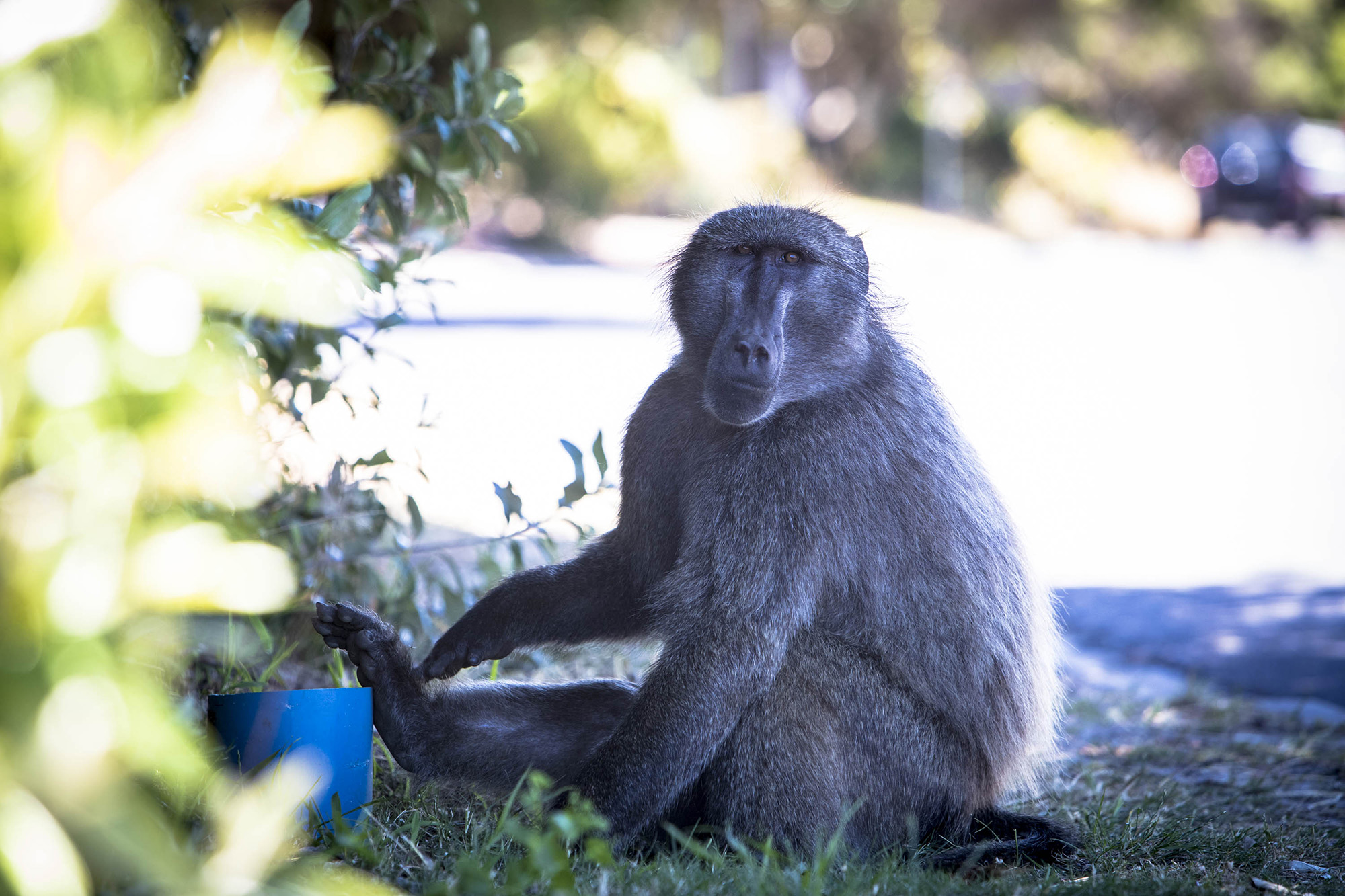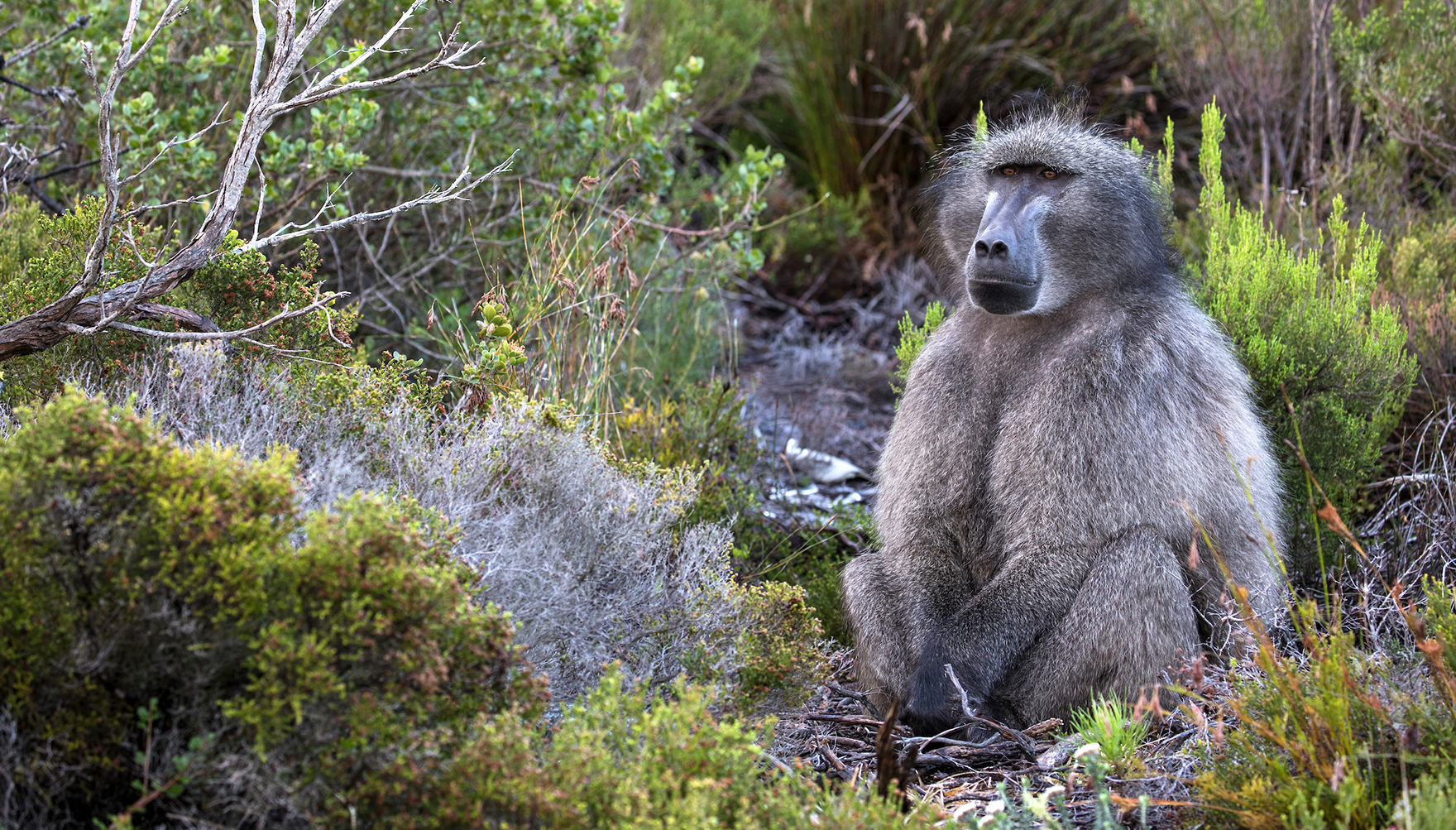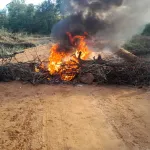In September 2020, a group of about 50 animal activists gathered at the bottom of Ou Kaapse Weg over the Silvermine Reserve in Cape Town, in a tense stand-off against baboon rangers of Human Wildlife Solutions (HWS), wanting to recapture Kataza, the chacma baboon that had been “relocated” from Slangkop to Tokai by the City of Cape Town.
The stand-off was eventually defused, the city capitulated and Kataza was returned to Slangkop temporarily before the “problem” baboon was exported to a rehabilitation centre in Limpopo.

Kataza in Kommetjie’s commercial centre. (Photo: Alan Van Gysen)

Kataza rests in the shade of an urban tree, grooming himself, alone in Kommetjie for the first week of his returned release in 2020. (Photo: Alan Van Gysen)

A #bringkatazaback sign hangs in Kommetjie to highlight and promote the safe return of Kataza the male baboon to his troop in the town, 2020. (Photo: Alan van Gysen)
Deep South Vibes: Kataza’s ‘homecoming’ – Can we all get along?
As I pen this on Christmas Day 2022, activists of the Pringle Bay community have told me they are threatening direct action to stop the relocation of four adult male chacma baboons from their baboon troop. Those activists are monitoring the HWS baboon rangers — the same HWS involved in the 2020 standoff — preparing to form a human chain to stop the threatened relocation, if necessary.
The situation in Pringle Bay has deteriorated; especially since the appointment of HWS by the Overstrand Municipality. Many residents are outraged at the cruel methods of herding (chasing with paintball guns) the baboons from their sleep site in the morning, through the day and back again every evening. While not confined to a cage, the baboons are in all other respects “captive”.
Before 2020, the Pringle Bay community had organised itself to recruit and manage its own baboon monitors. It set up an “early warning” communication system, to be alerted of the troop’s movements — baboon monitors gently escorted the baboons through and out of the village, back into the mountains. It worked. A similar scheme worked in Kommetjie, on the Cape Peninsula.
Then Overstrand appointed HWS, despite warnings from activists about the heavy-handed methods that had made it so unpopular with activists on the Cape Peninsula, where it lost the contract with the City of Cape Town Municipality; not to mention the controversy over its appointment by deviating from the tender process, which was subsequently found to be flawed.
Within months of HWS’s appointment, the raiding incursions shot up from six to nearly 19 per month.
In their endeavours to keep the troop out of the village (and achieve its performance objectives), HWS attempted to relocate the troop of 19 to the Buffelsdale area, but like any wild animal, baboons are not inclined to be relocated. When the troop returned they were reduced to 10 and the dominant alpha male had disappeared; much to the suspicion of activists.

Brutus, an adult male baboon of the Betty’s Bay baboon troop was shot on Saturday and had to be euthanased in March 2022 as a result of his injuries. Here he sits in the fynbos of the Kogelberg Biosphere Reserve in Bettys, Western Cape. (Photo: ©Pete Oxford)
Without a strong, mature, dominant alpha male, baboons tend to disperse individually; so instead of moving through Pringle Bay as a unit, HWS had reduced the troop to a bunch of uncontrollable individuals, which scattered into the village. Raiding incursions shot up again to 35.3, and then in the first six months of 2022 to 42.5.
Clearly, the methods employed by HWS are not only ineffective but counterproductive and divisive, hence the human-on-human conflict that arose, when activists felt compelled to intervene.
Writing about the situation in Overstrand on the Baboon Matters Facebook page, activist Jenni Trethowan notes: “… the aggressive management strategies and continual killing of dominant males has resulted in troops in disarray and it seems, from the limited data available through the service provider reports, that troops still enter human-occupied spaces for easy food rewards.
“It is quite possible that the high-stress levels created through aggressive tactics may have exacerbated the drive for baboons to get easy food rewards (high sugars and carb content) from human areas… if you are continually being chased, or moved, shot at or threatened, it is not as easy to spend the time required for natural foraging, therefore it may be easier to take the ‘hits’ and grab human-derived food as quickly as you can, where you can. The collective frustration advocates, activists and residents feel regarding the current systems is that clearly the inflexible methods are not working.”
Before being appointed by Overstrand Municipality, HWS had a history on the Cape Peninsula, where they made themselves unpopular.
A jaw-dropping admission
But, in a jaw-dropping admission in April, the City of Cape Town conceded it had “no mandate” to manage baboons, after squandering at least R120-million — the city refuses to disclose the exact figure. There was no formal announcement; only a casual slip by the city’s PR person, Kay Montgomery, at a meeting of the Invasive Species Forum.
Not surprisingly, Marian Nieuwoudt, the Mayco member responsible for that “unmandated” expenditure, had disappeared from the Mayoral Committee, and the formal acknowledgement that followed came from the new incumbent, Edwin Andrews, who admitted that:
“The City’s Urban Baboon Programme is intended to keep baboons within their natural habitat, and out of urban areas as far as possible. However, the city does not have a mandate to protect private properties, also, in terms of the Municipal Finance Management Act public funds cannot be used to secure private properties. As such, private property owners in this area are responsible for protecting their own properties, as is the case with all private properties across the metropole.”
How then did the city spend more than R120-million protecting the private property of what are mostly affluent areas on the urban edges of the Table Mountain National Park?
There is evidence that the city never approached the problem (human-baboon conflict) as an environmental or biodiversity issue, but rather as a security issue. Thus, the city has never had the interests of the environment or the chacma baboons in mind, or at heart.
No, it was the activists that cared. But the city took no notice of the complaints from activists; “activists” being those who wish to change the status quo; and who for the most part are motivated by care, since they regard the management techniques as cruel and unnecessary; especially so, because they are also largely ineffective or counter-productive.
Nobody disagrees that humans do not want baboons in their homes — what we disagree about is how to keep them out. If waste and foodstuff are not accessible, chacma baboons have no incentive to be on people’s property.
Visit Daily Maverick’s home page for more news, analysis and investigations
The evidence was ignored
But the city and CapeNature dismissed and ignored all the evidence provided by citizens that contradicted the data and reporting provided by HWS.
- The city ignored data compiled by residents which contradicted the data and reporting provided by HWS; upon which data HWS proposed the killing of “problem” baboons, like Kataza.
- The city also ignored eyewitness reports of HWS paintballing baboons in the mountain areas of Slangkop and the Lewis Gay Dam, in violation of the paintball protocols.
- And it dismissed challenges to the supposed science of “aversive conditioning”, on which basis HWS adopted paintballing and other methods of creating a “landscape of fear” to control baboons.
Further to that, the authorities have never produced evidence of having any oversight of HWS’s day-to-day operations.
The city declined to respond to data presented by residents that HWS data and reports were flawed; CapeNature admits it accepts the bona fides of permit applications without any independent investigation or verification.
The city sought legitimacy for its programme through hunting permits issued by CapeNature, for an activity which is more like herding.
CapeNature’s mandate is to manage and conserve our nature reserves and to promote the biodiversity of our environment. So, how then did CapeNature come to support and endorse with its permits an operation which does not have biodiversity as its core objective?
When confronted about the validity of permits issued for the City of Cape Town’s Urban Baboon Programme, for which it had conceded it had “no mandate”, CapeNature’s response, via spokesperson Zohra Parkar in May, was: “We obviously advise and support where we can.
“In terms of its mandate, CapeNature has no obligation to keep baboons out of urban areas; the entity is not responsible for nuisance animals, nor waste management. The entity also does not have any mandated obligation towards the health and safety of city residents. We obviously advise and support where we can.”
It is clear that our municipalities and CapeNature are failing to preserve our biodiversity. Where they are unable to control the movements of individual baboons, they seek to kill them; and where there is public outrage that prevents the killing, they seek to “relocate” the problem.
And they are not hearing the activists say: “There must be a better way of doing this — a more humane approach that does not necessitate us losing the chacma baboons from the peninsula or Overstrand. Instead, activists are labelled ‘crazies’ who think baboons are smaller, cuddly humans.”
But, there is a deeper issue that is best illustrated by placing the issue in a historical perspective.
When the Dutch settlers arrived in the Cape in 1652, there was an abundance and diversity of wildlife, which included lions, leopards, cheetahs, elephants, rhinoceroses, hippopotami, hyenas, baboons, foxes, ostriches… not to mention a variety of antelope and birdlife.
The Cape Colony was so vulnerable to lions that in about 1656 Jan van Riebeeck instituted a reward system, a bounty awarded for the killing of wild carnivores. “For catching and shooting a lion the reward was two-thirds a Spanish dollar and a leopard or hyena half a dollar,” writes Cuthbert Skeade in his Historical Incidence of the Larger Land Mammals in the Broader Western and Northern Cape (Skeade, 2011).
The last leopard
According to the Cape Leopard Trust, “Most sources believe leopards had already disappeared from the Peninsula by the late 1800s, but according to the Hout Bay Museum, the last leopard spotted in Hout Bay was apparently seen on Little Lion’s Head, above Llandudno, in 1937.”
“Where did they go?” is the obvious but rhetorical question. The more pertinent observation is that the last 370 years illustrate a long history of human-wildlife conflict and a gradual but constant degradation of our environment and our biodiversity. And where is it taking us?
While it was lions, leopards and larger mammals that threatened human security and resources, today the largest remaining free-roaming mammals on the Cape Peninsula are the chacma baboons. But that historical perspective is lost on each generation, which awakes to find only what is left and is oblivious to the species that have already been lost.
With that observation, comes the realisation the chacma baboons — the largest of the remaining mammals — are now at the forefront of this assault on our biodiversity. And what will we do with that realisation?
For as long as the human population is increasing, there will be an increasingly greater demand on our natural resources, with which we manufacture and operate our houses, cars, stoves, fridges, washing machines, mobile phones, etc. We seem to have lost sight of the fact that humans depend upon and live off the natural resources of our environment. And, by continuing the assault on our environment, we undermine the basis of our own existence — that thing we are an integral part of.
Our arrogance has been to put ourselves at the heart and centre of everything; as if nature is to serve us, rather than to see ourselves subordinate to nature.
The city’s own environmental policy states: “Natural resources and services are finite and the implications of this on how the economy and society functions and grows need to be recognised in order to ensure long-term viability. This must occur within a framework of good governance and considered decision-making that ensures that these assets, their current functions and future potential are not undermined, and that a burden is not left for future generations. Most importantly, Cape Town’s natural environment is a common asset belonging to all citizens of Cape Town, which must remain accessible and deliver benefits to all citizens — both current and future generations.”
So, what happened? Is this just lip service? There must come a “tipping point” beyond which it is no longer in our own interest to continue to degrade that which sustains us. And it is at that tipping point that human-wildlife conflict evolves into human-human conflict.
So, where will it stop? And what other conclusion are we faced with except that, if we cannot save the chacma baboons, here on the Cape Peninsula and Overstrand — without exporting our “problems” to Limpopo — what can we save? DM/OBP


















Here’s the truth. Every clear thinking person living or owning property in Pringle Bay is sick and tired of these pesky baboons. Its a minority woke community that believe its ok to become a prisoner in your own home. A door or window even 2 stories up cannot be left even slightly open without the risk of major damage in your home. Get real people, wild animals and people dont mix well. 50 years plus of issues in various towns of western cape have yet to find a solution… keep looking and good luck, in reality here is only one solution.
The authors criticisms are justified but offers no humane solution.
In 1993 I worked at Cape Point at the Goldfields environmental centre and it was surrounded by an electric fence. The baboons would test for and learn the frequency of the pulse and time their jump over the fence perfectly. The rangers all carried catapults but the baboons quickly learned who was a good shot, broken down by race and gender I might add. Sexist, racist creatures they are. Point is they are incredibly intelligent. But then so are all the animals that humans label as a problem. Bears in Yosemite peel back the frames of windows, marmots chew the brake lines to get at the fluid, and foxes in London cause havoc on pick up day. I had the privilege of grading Eskom Expo projects and one of the best ones was about the vervet monkeys at a Kloof primary school. The monkeys learned the timetable and would ambush teachers and students to get at the packed lunches.
Humans sometimes lack that intelligence and blowing out the brains of a baboon can be messy, as one of our Pringle bay neighbour’s discovered. Plus Cape Nature, despite its contradictory approach to baboon management, rightly threw the book at them.
It seems that in all these cases a messy and unsatisfactory management of the challenge continues because the two extremes of genocide or a complete hands off approach are equally unworkable. So the only humane solution is to muddle ones way through and prevent a lurch towards either extreme.
I’m sure the clear thinking and intelligent baboons are tired of pesky humans shooting at them and building homes in terrritory within which they used to roam and forage.
However, I don’t think that’s the point. No-one is suggesting that the issue be ignored and baboons be invited in to raid homes whenever they feel like a snack.
The point is that current strategies used by authorities are not working and exacerbating the ‘problem’.
It seems like the local initiative to monitor and herd troops out of the area was far more successful and didn’t disrupt troop structures.
Looking back, future generations will wonder why we didn’t try harder to co-exist with non-human animals and to respect their right to share the land with us.
A dominant male baboon controls his troop to the extent that he is the largely the only mating male in the group. The pringle bay troop is now so dispersed from the dominant male that i see young males and females mating on every rooftop around our house. While they are enjoying themselves , no doubt, the end result is ultimately more disorganization and monkey mayhem in the so called troop. The troop is scattered so much by the so called monitors chasing them around all day long that the dominant male has no control over his troop. Julle pluk n lat vir julle eie gatte, as they say in Afrikaans.
So even with this comprehensive analysis of the situation, not a single solution is suggested.